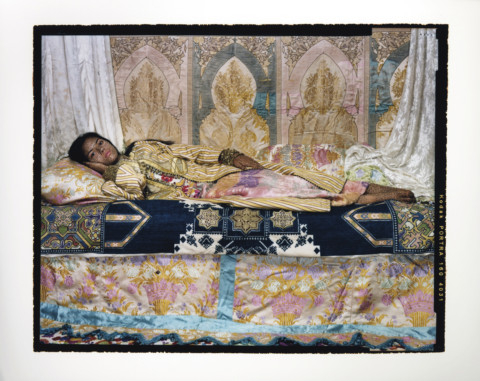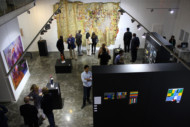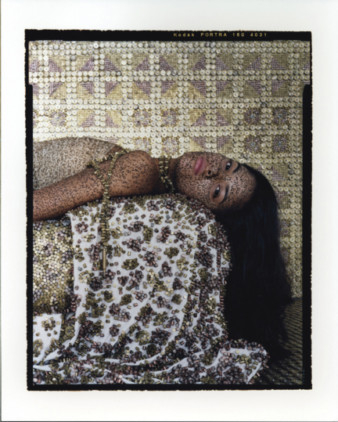
Dubai: Collections of $6.4 million (Dh23.5 million) — including a substantial $987,750 for a single work — over an intense two-day bidding and selling process sure translate into a lot of small change. For the esteemed auction house of Christie’s it was finding the trove at the end of the rainbow… again.
“No business is immune from the events taking place around it, but the reassuring pattern that has emerged since then [the downturn of 2009] is of solid sales with consistently high sold rates,” said Michael Jeha, managing director at Christie’s in the Middle East. “This points to a marketplace which has found its level and we continue to build upon this stable foundation.
“There is certainly less speculation and buyers are well-informed and do their research before they buy.”
At the Christie’s event last week – which showcased Middle East art and a regular feature in the local auction calendar since 2006 – only two of the 103 works went unsold. The final sales tally of $6.4 million represented a significant gain over the pre-auction high estimate of $5.5 million.
Moreover, the top bid of $987,750 for Iranian artist Farhad Moshiri’s Secret Garden “was just shy of the record price set at the height of this market in 2008,” said Jeha. “Since then, the increasing interest of international buyers and the maturing of an ever-increasing group of informed and committed local collectors continue to provide us with a sustainable market from which we will continue to build our business in the region.”
Local affair
The Dubai auction process is far from being a strictly local affair. Last week, 24 per cent of those who placed bids were new to Christie’s. There were 29 bidders, many of them GCC nationals, participating online via “Christie’s Live”.
“With international collectors in our Dubai sales representing around 50 per cent of the buyers, we feel confident that the sale format is right for us,” said Jeha. “Also, clients who begin with us in Dubai are increasingly interested in buying in sale categories held at our other salerooms. Importantly, they do still participate in the Dubai sales as both consignors and buyers.”
New communities and commercial clusters are paving the way for a rash of art galleries, and where art flourishes auction houses cannot be far behind.
Dadiba Pundole, owner of Pundole Art Gallery and Pundole’s auction house in India, will soon be opening a base in Dubai. He has finally decided on one named Sovereign, at the Palladium at JLT. “It is every buyer’s dream to invest in the Next Big Thing, but not every-one is successful at it,” said Pundole, who has also served as senior art consultant on modern and contemporary Indian art to Sotheby’s and sold a few M.F. Hussains in his time. “Coveting does not amount to collecting — it can only happen in a strong economic climate, but when there is a lull in the market, buyers are neither adventurous nor careless.
“Every investor ...has to be clear about what he or she is looking for. Only then can they identify where to look for it. It is what they want to collect that they are interested in… and will eventually buy.”
It was in the heady days of unfettered excessiveness of late 2007 and the better part of 2008 that many local residents got caught up with art as an investment option. If they could not buy up an Old Master, a modern or contemporary artist would do just fine as long as they had a painting — in a gilt-edged frame, of course — to hang up on the wall. Their “informed” decisions were based purely on what these works of art were fetching at that time.
Speculation
So, was there a herd mentality at work? “I might describe it differently — it is true to say there was some speculation,” said Jeha. “But collectors are increasingly well-informed about the works they want to buy and how much they feel is a fair price to pay for them.
“In our sales this week, 24 per cent of those who bid were new to Christie’s — in a growing market, looking to the future is critical.”
There is another tack Christie’s is following — it has created a Part II sales category offering a window to the works of upcoming artists from the region. The intention is to create that depth to the auction marketplace and not being limited to the top end of the bidding spectrum.
“By aligning these two strategies with our regular Part I and Part II format, we continue to be encouraged by the solidity shown in this market and the sustainable way it has matured,” said Jeha. “Many artists in the inaugural Christie’s sale are now represented in the world’s most prestigious institutions and museums.”
Therein lies the rub. With each high-profile auction revealing yet another price level for an artist or individual work, canny investors would want to get a piece of the action. Art will always be on an investor’s radar, though it will have its cycles of ebbs and flows as any other investment option.
“We’ve witnessed firsthand the passion of art collectors from across the region; the art market continues to flourish in the Middle East, showcased by a vibrant art scene typified most recently at Art Dubai,” said Jeremy Baggott, head of Zurich Private Clients in the Middle East.
Middle East art is getting the full treatment. Auction houses — global names as well as of local flavour — are providing the bold strokes to make it flourish.















